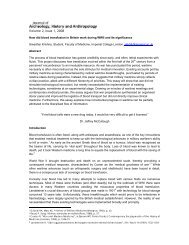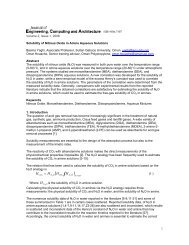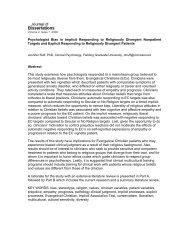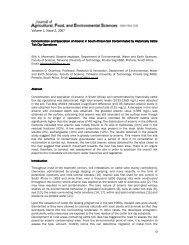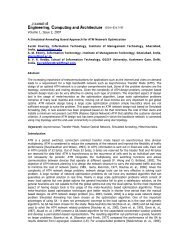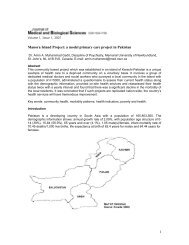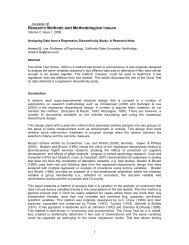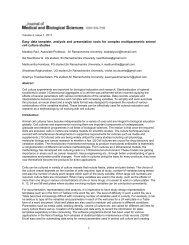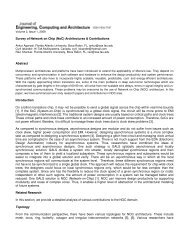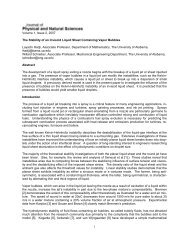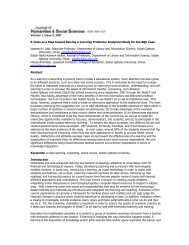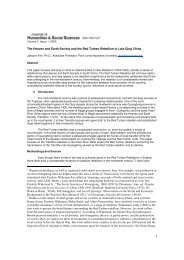AgNOR expression in Central Nervous System Tumors - Scientific ...
AgNOR expression in Central Nervous System Tumors - Scientific ...
AgNOR expression in Central Nervous System Tumors - Scientific ...
You also want an ePaper? Increase the reach of your titles
YUMPU automatically turns print PDFs into web optimized ePapers that Google loves.
Volume 4, Issue 1, 2011<br />
<strong>AgNOR</strong> <strong>expression</strong> <strong>in</strong> <strong>Central</strong> <strong>Nervous</strong> <strong>System</strong> Tumours<br />
Dr. Sushil Lakra M.D., Assistant Professor, Department of Pathology, Faculty of Medic<strong>in</strong>e, Misurata University,<br />
Libya. sushil_lakra2003@yahoo.com<br />
Abstract<br />
<strong>AgNOR</strong> (Argyrophilic nuclear organizers regions) technique is simple, rapid, <strong>in</strong>expensive and can be performed<br />
on formal<strong>in</strong> fixed, paraff<strong>in</strong>- embedded tissue <strong>in</strong>clud<strong>in</strong>g archival material. Therefore, unlike most available<br />
‘proliferation’ techniques, it does not require special process<strong>in</strong>g of tissue. When a set of observers and laboratory<br />
become familiar with the technique, count<strong>in</strong>g of <strong>AgNOR</strong> should be <strong>in</strong>cluded as one of the techniques <strong>in</strong> rout<strong>in</strong>e<br />
diagnosis along with Haematoxyl<strong>in</strong> and Eos<strong>in</strong> sta<strong>in</strong><strong>in</strong>g <strong>in</strong> decid<strong>in</strong>g the dist<strong>in</strong>ction between normal bra<strong>in</strong> tissue and<br />
case of def<strong>in</strong>ite low grade astrocytoma. Therefore, if <strong>AgNOR</strong> is used <strong>in</strong> concert with cl<strong>in</strong>ical <strong>in</strong>formation and<br />
rout<strong>in</strong>e light microscopy, the <strong>AgNOR</strong> technique may prove adjunct <strong>in</strong> pathological dist<strong>in</strong>ction between normal<br />
bra<strong>in</strong> tissue show<strong>in</strong>g gliosis and low grade astrocytoma and dist<strong>in</strong>ction between benign and malignant tumors.<br />
The conclusion drawn from the present study is that the <strong>AgNOR</strong> technique can be used to dist<strong>in</strong>guish between<br />
normal and benign lesions, benign and malignant lesions, and low versus high grade malignant lesions.<br />
Introduction<br />
Argyrophilic nucleolar organizers regions (<strong>AgNOR</strong>) which are identified by a silver sta<strong>in</strong><strong>in</strong>g technique have been<br />
reported to reflect cellular activity and proliferative potential (Egan M.J. 1988). Nucleolar organizer regions may<br />
be visualized by number of ways. The simplest and most widely used method is silver colloid impregnation. This<br />
technique has been shown to be specific for carboxyl and sulphydryl-rich prote<strong>in</strong>s associated with NOR (Nuclear<br />
organizer region) (Crocker J. 1990). The technique is rapid and can be performed on formal<strong>in</strong> fixed paraff<strong>in</strong><br />
embedded tissue. The <strong>AgNOR</strong> method has been used both to grade human tumors and dist<strong>in</strong>guish benign from<br />
malignant lesions (Editorial 1990).<br />
NORs have attracted much attention because of claims that their frequency with<strong>in</strong> nuclei is significantly higher <strong>in</strong><br />
malignant cells than <strong>in</strong> normal, reactive or benign neoplastic cells. Because NORs can now be demonstrated <strong>in</strong><br />
rout<strong>in</strong>ely processed histological sections, the techniques are obviously of potential value <strong>in</strong> diagnostic<br />
histopathology (Underwood J.C.E.1988). The pr<strong>in</strong>cipal advantage of the <strong>AgNOR</strong> technique is the relative<br />
simplicity of the sta<strong>in</strong><strong>in</strong>g method and the ease of its application to archival tissue. Disadvantages <strong>in</strong>clude the time<br />
consum<strong>in</strong>g and tedious count<strong>in</strong>g of the little dots, often clustered associated with the usual vagaries of observer<br />
error (Underwood J.C.E.1992).<br />
The <strong>AgNOR</strong> method can be applied to various materials <strong>in</strong>clud<strong>in</strong>g cells <strong>in</strong> smears, semi-th<strong>in</strong> sections of plastic<br />
embedded cells and sections of paraff<strong>in</strong> embedded human pathological specimens. Nuclear organizer regions<br />
have been shown to reflect cellular proliferation or malignancy, although they are not directly related to the cell<br />
cycle. NORs are loops of ribosomal DNA present <strong>in</strong> nucleoli. The DNA poss esses ribosomal RNA genes that are<br />
transcribed to ribosomal RNA by RNA polymerase I. NORs are demonstrated by means of the argyrophilia of<br />
their associated prote<strong>in</strong>s (<strong>AgNOR</strong>s) such as RNA polymerase I, C23 prote<strong>in</strong> and B23 prote<strong>in</strong>. These prote<strong>in</strong>s are<br />
thought to play some role <strong>in</strong> the transcription of ribosomal RNA (A. Hara 1991). In the human karyotype NORs<br />
are located on the short arms of chromosomes 13, 14, 15, 21, and 22 (Underwood J.C.E.1988).<br />
In <strong>Central</strong> <strong>Nervous</strong> <strong>System</strong> (CNS) tum ors, many times the light microscopic dist<strong>in</strong>ction between gliosis and low<br />
grade astrocytoma is difficult with Haematoxyl<strong>in</strong> and Eos<strong>in</strong> (H&E) sta<strong>in</strong>ed sections. It can be evaluated with the<br />
use of the <strong>AgNOR</strong> impregnation (David N. Louis 1992). It has been thought that <strong>AgNOR</strong> impregnation can be<br />
used as an additional diagnostic <strong>in</strong>dex to provide help <strong>in</strong> differentiat<strong>in</strong>g reactive gliosis and benign or malignant<br />
tumors of CNS. It may helpful to assess the prognosis of the lesions (Louis D.N. 1992).<br />
When us<strong>in</strong>g cytological impr<strong>in</strong>t preparation <strong>in</strong> studies, the <strong>AgNOR</strong> count is found to be much higher for low grade<br />
astrocytoma than <strong>in</strong> sections of paraff<strong>in</strong> embedded pathological studies. It also showed a rough correlation<br />
between <strong>AgNOR</strong> count and astrocytoma grades. For <strong>in</strong>stance the use of cytologic preparation may give higher<br />
count presumably because all <strong>AgNOR</strong>s <strong>in</strong> nucleus are visible not just those present <strong>in</strong> 3 micron thick tissue<br />
sections (Plate K.H. et. al 1990).<br />
1
The present study was designed to compare mean <strong>AgNOR</strong> counts <strong>in</strong> benign and malignant neoplastic lesions of<br />
the central nervous system and to f<strong>in</strong>d out the utility of <strong>AgNOR</strong> count <strong>in</strong> diagnosis of central nervous system<br />
neoplasms.<br />
Objectives<br />
1. To compare mean <strong>AgNOR</strong> count <strong>in</strong> benign and malignant neoplastic lesions <strong>in</strong> central nervous system.<br />
2. To f<strong>in</strong>d out utility of <strong>AgNOR</strong> count <strong>in</strong> diagnosis of central nervous system neoplasms.<br />
3. To compare <strong>AgNOR</strong> count with histological grad<strong>in</strong>g of central nervous system tumors.<br />
4. To compare the present study with other workers’ studies.<br />
Materials and Methods<br />
The present study was conducted on surgical biopsies from 100 cases of CNS which were over a period from<br />
July1996 to July 1998 received <strong>in</strong> the department of pathology, Gajra Raja Medical College Gwalior, Madhya<br />
Pradesh, India. Surgical biopsies were colleted <strong>in</strong> 10% buffered formal<strong>in</strong> from cases undergo<strong>in</strong>g surgery. The<br />
biopsies were subjected to rout<strong>in</strong>e paraff<strong>in</strong> sections. Histopathological diagnosis was first established on these<br />
sections obta<strong>in</strong>ed from paraff<strong>in</strong> blocks us<strong>in</strong>g the rout<strong>in</strong>e H&E sta<strong>in</strong>s. Other paraff<strong>in</strong> blocks sections were<br />
subjected to the <strong>AgNOR</strong> sta<strong>in</strong><strong>in</strong>g technique.<br />
Paraff<strong>in</strong> sections:<br />
The tissue was fixed <strong>in</strong> 10% formal<strong>in</strong>.<br />
Pieces of the fixed tissue were subjected to the procedures of the dehydration, clean<strong>in</strong>g and embedd<strong>in</strong>g<br />
<strong>in</strong> automatic tissue processor.<br />
The dehydrated cleared tissue pieces were further impregnated with paraff<strong>in</strong> wax by immersion <strong>in</strong> a<br />
succession of wax bath on the automatic tissue processor.<br />
The treated tissue was embedded <strong>in</strong> paraff<strong>in</strong> wax. The blocks were made us<strong>in</strong>g a shaped metallic<br />
mould. The embedded tissue blocks were allowed to cool.<br />
The paraff<strong>in</strong> wax blocks were fixed on a rotary microtome and sections of 4 µm thickness were cut.<br />
The cut sections were transferred to a water bath and thereby picked on album<strong>in</strong> filmed glass slides.<br />
The sections were fixed to the slides by keep<strong>in</strong>g them <strong>in</strong> <strong>in</strong>cubator at 37° C overnight.<br />
The sections were then subjected to the H&E and <strong>AgNOR</strong> sta<strong>in</strong>s.<br />
H&E Sta<strong>in</strong> (Haematoxyl<strong>in</strong> and Eos<strong>in</strong> sta<strong>in</strong>):<br />
Paraff<strong>in</strong> sections obta<strong>in</strong>ed were <strong>in</strong>cubated at 37° C overnight.<br />
The sections were dewaxed <strong>in</strong> xylene, hydrated through various grades of alcohol.<br />
Sections were r<strong>in</strong>sed <strong>in</strong> runn<strong>in</strong>g water for one m<strong>in</strong>ute and then briefly <strong>in</strong> distilled water.<br />
Sections were sta<strong>in</strong>ed <strong>in</strong> Ehrlich′s Haematoxyl<strong>in</strong> for 8 m<strong>in</strong>utes.<br />
Differentiation was done by dipp<strong>in</strong>g the sta<strong>in</strong>ed sections <strong>in</strong> 1% acid alcohol (1ml conc. HCl to 99ml of<br />
80% ethyl alcohol).<br />
Sections were r<strong>in</strong>sed <strong>in</strong> water.<br />
Sections were blued by plac<strong>in</strong>g them <strong>in</strong> tap water until the sections appeared blue.<br />
Sections were r<strong>in</strong>sed well <strong>in</strong> water.<br />
Sections were sta<strong>in</strong>ed with aqueous eos<strong>in</strong> Y for 2 m<strong>in</strong>utes.<br />
Sections were r<strong>in</strong>sed well <strong>in</strong> water.<br />
Sections were dehydrated through different grades of alcohol.<br />
Dehydrated sections were passed through two baths of xylene.<br />
Sections were dried and mounted with 80 Dibutylphthalate xylene (DPX) mountant.<br />
Preparation of <strong>AgNOR</strong> sta<strong>in</strong><strong>in</strong>g solution:<br />
A solution was prepared by dissolv<strong>in</strong>g 2 gm of gelat<strong>in</strong> <strong>in</strong> 1% aqueous formic acid to make 100 ml of<br />
solution at a concentration of 2%.<br />
50%aqueous silver nitrate solution was prepared by dissolv<strong>in</strong>g 5 gm of silver nitrate <strong>in</strong> triple distilled<br />
water to make 10 ml of solution.<br />
The solutions (a) and (b) were mixed <strong>in</strong> a proportion of 1:2 respectively to obta<strong>in</strong> the f<strong>in</strong>al <strong>AgNOR</strong><br />
sta<strong>in</strong><strong>in</strong>g solution.<br />
<strong>AgNOR</strong> sta<strong>in</strong><strong>in</strong>g technique:<br />
Paraff<strong>in</strong> sections were <strong>in</strong>cubated at 37° C overnight, further dewaxed <strong>in</strong> xylene, dehydrated through<br />
various grades of ethanol and washed well with triple distilled water. The sections were dried thoroughly<br />
and subjected to <strong>AgNOR</strong> sta<strong>in</strong>s.<br />
The <strong>AgNOR</strong> sta<strong>in</strong> prepared as mentioned above, was poured over the tissue sections and left for 60<br />
m<strong>in</strong>utes at room temperature.<br />
The silver colloid was washed off with triple distilled water thoroughly.<br />
Sections were dehydrated through various grades of alcohol and cleared <strong>in</strong> baths of xylene.<br />
Sta<strong>in</strong>ed sections were mounted with DPX mountant.
Precautions taken:<br />
Particular attention was paid to the cleanl<strong>in</strong>ess of glassware and purity of water <strong>in</strong> order to avoid background<br />
sta<strong>in</strong><strong>in</strong>g and non specific granular deposits on tissue sections.<br />
Count<strong>in</strong>g procedure:<br />
<strong>AgNOR</strong>s were counted as brown-black dots <strong>in</strong> the nuclei of cells us<strong>in</strong>g a 100X oil immersion objectives.<br />
100 cells were studied <strong>in</strong> each case; the mean <strong>AgNOR</strong> per nucleus was calculated.<br />
<strong>AgNOR</strong>s were counted <strong>in</strong> the normal bra<strong>in</strong> tissue, benign and malignant tumors of CNS cells. The cells<br />
<strong>in</strong> all above cases were chosen randomly.<br />
The f<strong>in</strong>al scores <strong>in</strong> normal bra<strong>in</strong> tissue, benign and malignant lesions were compared.<br />
The data obta<strong>in</strong>ed were subsequently correlated with the histopathological diagnosis.<br />
Results<br />
The present study was conducted on surgical biopsies from 100 cases of CNS tissue received <strong>in</strong> the department<br />
of pathology, Gajra Raja Medical College Gwalior, Madhya Pradesh.. There were 30 cases of normal bra<strong>in</strong><br />
tissue, 25 cases of astrocytoma <strong>in</strong> which there were 15 grades I & II and 10 grade III & IV, 10 cases of<br />
men<strong>in</strong>giomas, 13 cases of neurofibroma and 22 cases of others <strong>in</strong> which 4 cases of glioblastoma multiforme, 2<br />
cases of ependymomas, 5 cases of medulloblastomas, 2 cases of Schwanomas, 5 cases of heangioblastoma, 2<br />
cases of craniophangiomas and 2 cases of secondary metastatic tumors. Each of these specimens was<br />
subjected to paraff<strong>in</strong>. H&E sta<strong>in</strong><strong>in</strong>g was done on one paraff<strong>in</strong> section and one section was sta<strong>in</strong>ed by the <strong>AgNOR</strong><br />
sta<strong>in</strong><strong>in</strong>g technique.<br />
The sections were exam<strong>in</strong>ed under oil immersion objective 100X. <strong>AgNOR</strong> were visible as dark brown <strong>in</strong>tranuclear<br />
dots, aga<strong>in</strong>st yellowish background. They were counted <strong>in</strong> 100 cells <strong>in</strong> each section. Each dot was class ified as<br />
small, medium and large accord<strong>in</strong>g to its size.<br />
A small dot was def<strong>in</strong>ed as just visible but dist<strong>in</strong>ct. A dot about three times the size of small was classified as<br />
medium and those about five times or more classified as large dots. Care was taken to count <strong>AgNOR</strong> <strong>in</strong> groups<br />
of cells.<br />
Fields were selected at random and 100 cells were taken <strong>in</strong>to count. The mean number of <strong>AgNOR</strong>s per cell is<br />
then calculated. Simultaneous morphology of <strong>AgNOR</strong> dots was also observed. The <strong>AgNOR</strong> dots ly<strong>in</strong>g <strong>in</strong> groups<br />
and clusters were counted as one structure.<br />
In benign lesions the <strong>AgNOR</strong>s were small, round and regular while <strong>in</strong> malignant lesions the <strong>AgNOR</strong>s were often<br />
angulated and irregular. Errors were avoided by count<strong>in</strong>g <strong>AgNOR</strong>s <strong>in</strong> th<strong>in</strong>nest part of the sections. S<strong>in</strong>gle naked<br />
nuclei present <strong>in</strong> background were not taken <strong>in</strong> analysis.<br />
The histopathological diagnosis of each case was based ma<strong>in</strong>ly on the H&E sta<strong>in</strong>ed sections.<br />
Table 01: Comparative mean <strong>AgNOR</strong> count <strong>in</strong> normal bra<strong>in</strong> tissue and astrocytoma:<br />
S.NO. Groups Range of <strong>AgNOR</strong> mean <strong>AgNOR</strong> count/100 cells<br />
count/100 cells<br />
1 Normal bra<strong>in</strong> tissue 0.68 to 1.28 0.87±0.14<br />
2 Astrocytoma grade I &II 1.00 to 1.80 1.17±0.19<br />
3 Astrocytoma grade III &IV 1.65 to 2.38 2.05±0.17<br />
Table 1 shows the comparative mean <strong>AgNOR</strong> count <strong>in</strong> three different grades of bra<strong>in</strong> tissue. In group I or normal<br />
bra<strong>in</strong> tissue the mean <strong>AgNOR</strong> count is 0.87±0.14. In group II or astrocytoma grade I &II the mean <strong>AgNOR</strong> count<br />
is 1.17±0.19. In group III or astrocytoma grade III &IV the mean <strong>AgNOR</strong> count is 2.05±0.17.<br />
Figure 01: Mean <strong>AgNOR</strong> counts <strong>in</strong> normal versus astrocytoma tissue.<br />
3
2.5<br />
2<br />
2.05<br />
1.5<br />
1<br />
0.5<br />
1.17<br />
0.87<br />
Astrocytoma grade III &<br />
IV<br />
Atrocytoma grade I &II<br />
Normal bra<strong>in</strong> tissue<br />
0<br />
Figure 01 shows the mean count <strong>in</strong> a normal versus astrocytoma tissue. X-axis represents the mean <strong>AgNOR</strong><br />
count per 100 cells and Y-axis <strong>in</strong>dicates the normal bra<strong>in</strong> tissue, astrocytoma grade I &II and astrocytoma grade III<br />
&IV. Astrocytoma grade III & IV has the highest <strong>AgNOR</strong> count when compared with astrocytoma grade I &II and<br />
normal bra<strong>in</strong> tissue.<br />
Table 02: Comparative mean <strong>AgNOR</strong> count <strong>in</strong> different benign tumors:<br />
S.NO Types of benign tumors Range of <strong>AgNOR</strong> count/100 Mean <strong>AgNOR</strong> count /100 cells<br />
cells<br />
1 Schwannoma 1.40 to 1.80 1.60 ± 0.20<br />
2 Neurofibroma 0.78 to 2.10 1.32 ±0.32<br />
3 Men<strong>in</strong>gioma 1.00 to 2.80 1.87 ±0.42<br />
4 Craniopharyngioma 2.0 to 2.20 2.10 ±0.20<br />
Table 02 shows the comparative mean <strong>AgNOR</strong> count <strong>in</strong> different benign tumors of CNS. Craniopharyngioma<br />
showed highest mean <strong>AgNOR</strong> <strong>in</strong>dex (2.10 ±0.20) with variation among the <strong>in</strong>dividual count (range from 2.00 to<br />
2.20). Other subgroups Schwannoma, neurofibroma and men<strong>in</strong>gioma were found to have mean <strong>in</strong>dices close to<br />
each other 1.60 ± 0.20, 1.32 ±0.32 and 1.87 ±0.42 respectively.<br />
Figure 02: Comparative mean <strong>AgNOR</strong> counts <strong>in</strong> different benign tumors:<br />
2.5<br />
2<br />
1.5<br />
1.6<br />
1.32<br />
1.87<br />
2.1 Schwannoma<br />
Neurofibroma<br />
1<br />
Men<strong>in</strong>gioma<br />
0.5<br />
0<br />
Craniopharyngioma<br />
Figure 02 represents the comparative mean <strong>AgNOR</strong> counts <strong>in</strong> different benign tumors-<strong>in</strong>clud<strong>in</strong>g, schwannoma,<br />
neurofibroma, men<strong>in</strong>gioma and craniopharyngioma. The X- axis represents the mean <strong>AgNOR</strong> count/100cells and<br />
the Y-axis <strong>in</strong>dicates the different types of benign tumors. Craniopharyngiom has the highest <strong>AgNOR</strong> count and<br />
neurofibroma has the lowest compared to other benign tumors.<br />
Table 03: Comparative mean <strong>AgNOR</strong> count <strong>in</strong> different malignant tumors:<br />
S.NO. types of malignant tumors Mean <strong>AgNOR</strong> count /100<br />
cells<br />
1 Astrocytoma grade I &II 1.17±0.19<br />
2 Astrocytoma grade III &IV 2.05±0.17<br />
3 Glioblastoma multiforme 2.67 ±.64<br />
4 Haemangioblastoma 2.22 ±.44<br />
5 Ependymoma 3.88 ±.43<br />
6 Medulloblastoma 3.52 ±.43<br />
7 Secondary metastatic tumor 3.90 ±.90
Table 03 shows the comparative mean <strong>AgNOR</strong> count <strong>in</strong> different malignant tumors. Secondary metastatic tumor,<br />
medulloblastoma and ependymoma had the higher <strong>AgNOR</strong> count of 3.90 ±.90, 3.52 ±.43 and 3.88 ±.43<br />
respectively. Astrocytoma grade III &VI, glioblastoma multiform and haemangioblastoma had the mean <strong>AgNOR</strong><br />
count of 2.05±0.17, 2.67 ±.64 and 2.22 ±.44 respectively. The <strong>AgNOR</strong> dots were large, regular and easily<br />
identifiable <strong>in</strong> these cases.<br />
Figure 03: <strong>AgNOR</strong> counts <strong>in</strong> malignant CNS tumors :<br />
4<br />
3.5<br />
3.88 3.9<br />
3.52 Astrocytoma grade I &II<br />
3<br />
2.67<br />
Astrocytoma grade III<br />
&IV<br />
2.5<br />
2.22<br />
2.05<br />
Glioblastoma<br />
2<br />
multiforme<br />
Haemangioblastoma<br />
1.5 1.17<br />
1<br />
Ependymoma<br />
0.5<br />
Medulloblastoma<br />
0<br />
Secondary metastatic<br />
tumor<br />
Figure 03 represents the comparative <strong>AgNOR</strong> count <strong>in</strong> different malignant tumors of CNS.<br />
Secondary metastatic tumor shows the highest <strong>AgNOR</strong> count as compared to other malignancies. Ependymoma<br />
the primary malignant tumor showed the highest <strong>AgNOR</strong> count than other primary tumors.<br />
Discussion<br />
The present series reveal significant qualitative and quantitative difference between normal bra<strong>in</strong> tissue, low<br />
grade astrocytoma and high grade astrocytoma and between benign and malignant lesions of the central nervous<br />
system. Theses reports are discussed <strong>in</strong> light of other reports on the use of <strong>AgNOR</strong> count <strong>in</strong> bra<strong>in</strong> biopsies.<br />
The <strong>AgNOR</strong> technique has been applied to the study of normal bra<strong>in</strong> tissue <strong>in</strong> a number of studies. Hussa<strong>in</strong> N.et<br />
al (1997) demonstrated that normal bra<strong>in</strong> specimens showed little variation among the <strong>in</strong>dividual counts (range-<br />
0.61 to 1.14) with a mean <strong>in</strong>dex 0.94±0.24. The result of present study correlates with their study. The mean<br />
<strong>AgNOR</strong> count of normal bra<strong>in</strong> tissue is 0.87±0.14.<br />
The <strong>AgNOR</strong> dots <strong>in</strong> normal bra<strong>in</strong> tissue (1.40 to 1.80 of <strong>AgNOR</strong> count/100 cells) were small, discrete and not all<br />
the nuclei showed presence of dots <strong>in</strong> present study which is similar as N. Hussa<strong>in</strong> described. A astrocytoma<br />
grade I &II (1.00 to 1.80 of <strong>AgNOR</strong> count/100 cells) showed <strong>AgNOR</strong> were larger and irregular dots than normal<br />
bra<strong>in</strong>. In astrocytoma grade III &IV (1.65 to 2.38 of <strong>AgNOR</strong> count/100 cells) <strong>AgNOR</strong> dots were large, irregular<br />
and more than one <strong>in</strong> nuclei. Figure 01 shows astrocytoma grade III & IV has the highest <strong>AgNOR</strong> count when<br />
compared with astrocytoma grade I, II and normal bra<strong>in</strong> tissue.<br />
The <strong>AgNOR</strong> technique has been applied to study of astrocytoma <strong>in</strong> number of studies. Most have focused on the<br />
use of <strong>AgNOR</strong> <strong>in</strong> astrocytoma grad<strong>in</strong>g which were as given below <strong>in</strong> Table 04:<br />
Table 04: <strong>AgNOR</strong> count <strong>in</strong> astrocytoma <strong>in</strong> various studies:<br />
Studies<br />
Kajiwara et al<br />
1990<br />
Plate et al<br />
1990<br />
Hara et al<br />
1991<br />
Shirashi et<br />
al 1991<br />
Louis et.<br />
Al 1992<br />
H. Hussa<br />
<strong>in</strong> et al<br />
1997<br />
Present<br />
study<br />
Grade I &II 1.75 3.15 1.80 1.98 2.22 1.75 1.17<br />
Grade III & IV 2.01 4.5 2.87 2.41 2.94 2.2 2.05<br />
Table 04 shows an <strong>in</strong>crease <strong>in</strong> <strong>AgNOR</strong> counts with <strong>in</strong>creas<strong>in</strong>g grade of tumors. The present study also <strong>in</strong>dicates<br />
that <strong>in</strong>crease <strong>in</strong> <strong>AgNOR</strong> count with <strong>in</strong>creas<strong>in</strong>g astrocytoma grade. On compar<strong>in</strong>g our results with the published<br />
material we found that <strong>AgNOR</strong> count of astrocytoma grade I &II was lower. Kajiwara K. et. al (1990) showed a<br />
l<strong>in</strong>ear relationship between <strong>AgNOR</strong> count and S phase fraction as determ<strong>in</strong>ed by <strong>in</strong> vitro Bromodeoxy-urid<strong>in</strong>e<br />
(BRdU) label<strong>in</strong>g and found that patients with tumor <strong>AgNOR</strong> count of less than 1.80 had a better prognosis than<br />
those with tumor <strong>AgNOR</strong> count of greater than 1.80. Hara A. et. al (1991) showed a correlation between <strong>AgNOR</strong><br />
count and astrocytoma grades and a correlation between <strong>AgNOR</strong> count and proliferative potential as determ<strong>in</strong>ed<br />
5
y Ki-67 label<strong>in</strong>g. The <strong>AgNOR</strong> count was found by Hara A.et. al. <strong>in</strong> astrocytoma grade I &II was higher than <strong>in</strong><br />
our study. Plate et. al (1990) us<strong>in</strong>g cytological impr<strong>in</strong>t preparation <strong>in</strong> three separate studies, obta<strong>in</strong>ed much<br />
higher <strong>AgNOR</strong> count for low grade astrocytoma, but also showed rough correlation between <strong>AgNOR</strong> count and<br />
astrocytoma grades.<br />
Nicoll and Candy (1991) have demonstrated that <strong>AgNOR</strong> count, while correlat<strong>in</strong>g with mitotic rate, do not relate<br />
to the post operative survival <strong>in</strong> patients with glioblastoma multiforme. Therefore while <strong>AgNOR</strong> may provide<br />
additional <strong>in</strong>formation <strong>in</strong> assess<strong>in</strong>g tumor malignancy, the significance of the <strong>in</strong>formation rema<strong>in</strong>s unclear. In the<br />
present study, as follow up was not possible due to time limited study, it is difficult to comment on survival<br />
prognosis of these grades I &II tumors.<br />
The <strong>AgNOR</strong> dots <strong>in</strong> different benign tumors were large, regular and easily identifiable and the <strong>AgNOR</strong> dots <strong>in</strong><br />
different malignant tumors were smaller and more widely scattered throughout the nucleus as compared to those<br />
of benign cases. Craniopharyngioma has the highest <strong>AgNOR</strong> count, neurofibroma has the lowest compared to<br />
other benign tumors as showed <strong>in</strong> figure 02 and<br />
Secondary metastatic tumor shows the highest <strong>AgNOR</strong> count as compared to other malignancies. Ependymoma,<br />
the primary malignant tumor, showed the highest <strong>AgNOR</strong> counts of the primary tumors as showed <strong>in</strong> figure 03<br />
which is correlat<strong>in</strong>g to the results of other workers.<br />
The present study has shown relatively low <strong>AgNOR</strong> count <strong>in</strong> the low grade lesions such as astrocytoma grade<br />
I&II and relatively high count <strong>in</strong> higher grade lesions such as medulloblastoma, astrocytoma grade III&IV,<br />
metastatic carc<strong>in</strong>oma and haenagioblastoma.<br />
Silver nuclear organizer regions <strong>in</strong> neoplastic lesions tended to be larger than those <strong>in</strong> normal bra<strong>in</strong> tissue. The<br />
<strong>in</strong>crease <strong>in</strong> <strong>AgNOR</strong> size may reflect <strong>in</strong>creased nucleolar activity. It is important to note, however that the nucleoli<br />
of low grade astrocytoma, while <strong>in</strong>creas<strong>in</strong>g their size do not become compound and fragmented like the nuclei of<br />
higher malignant cells. Field D.H. (1984) this may be due to rapid proliferation <strong>in</strong> higher malignant cells, s<strong>in</strong>ce<br />
<strong>AgNOR</strong> may not completely aggregated <strong>in</strong> divid<strong>in</strong>g cells, thereby produc<strong>in</strong>g compound and irregular early<br />
lobulated nucleoli.<br />
Furthermore cl<strong>in</strong>ical studies have shown close correlation of <strong>AgNOR</strong> number and proliferation rate and imply that<br />
rapidly proliferat<strong>in</strong>g high grade malignant tumor cells have higher <strong>AgNOR</strong> count and more compound, irregular<br />
<strong>AgNOR</strong> than less rapidly proliferat<strong>in</strong>g low grade malignant tumor cells. These differential features provide a<br />
suitable tool for us<strong>in</strong>g <strong>AgNOR</strong> to dist<strong>in</strong>guish normal bra<strong>in</strong> tissue from neoplastic cells and have been used <strong>in</strong> the<br />
differential diagnosis of human malignancies (Croker J. 1990).<br />
In the CNS, Manuelidis L. (1984) has reported that there are strik<strong>in</strong>g difference <strong>in</strong> the quantity and quality of<br />
<strong>AgNOR</strong> between normal and neoplastic cells. It has been also demonstrated that <strong>AgNOR</strong>s are precisely<br />
positioned <strong>in</strong> the nuclei of normal, differentiated central nervous system cells while <strong>AgNOR</strong> <strong>in</strong> neuroectodermal<br />
tumor cells were large, multiple and variable <strong>in</strong> their nuclear position.<br />
The present study supports the f<strong>in</strong>d<strong>in</strong>gs of other workers by show<strong>in</strong>g significant quantitative and qualitative<br />
<strong>AgNOR</strong> difference between normal bra<strong>in</strong> and low grade astrocytoma. Low grade astrocytoma had greater than<br />
1.01 <strong>AgNOR</strong>/ nucleus and often had large and irregular <strong>AgNOR</strong> while normal bra<strong>in</strong> tissue had less than 1.20<br />
<strong>AgNOR</strong>/ nucleus and had small and regular compound <strong>AgNOR</strong>. The majority of low grade astrocytoma<br />
numbered over 1.00 <strong>AgNOR</strong>/ nucleus (mean= 1.17), Most cases of astrocytoma were well above the 1.01<br />
<strong>AgNOR</strong>/ nucleus with large and irregular <strong>AgNOR</strong> and are likely to be neoplastic.<br />
Variability <strong>in</strong> <strong>AgNOR</strong> count<strong>in</strong>g exists between laboratories and probably results from difference <strong>in</strong> impregnation<br />
and count<strong>in</strong>g techniques. For <strong>in</strong>stance the use of cytologic preparation may give higher count presumably<br />
because all <strong>AgNOR</strong> <strong>in</strong> nucleus are visible not just those present <strong>in</strong> 3 micron thick tissue section. Count may also<br />
be higher if 4 or 5 micron thick sections are used rather than the standard 3 micron. Counts may be lowered and<br />
perhaps even erroneous if one does not count all <strong>AgNOR</strong> <strong>in</strong>dividually i.e. multiple dist<strong>in</strong>ct <strong>in</strong>tranucleolar <strong>AgNOR</strong><br />
should be counted as multiple <strong>AgNOR</strong> and not as a s<strong>in</strong>gle <strong>AgNOR</strong>.<br />
Malignant lesions of the central nervous system had greater than 1.17 mean <strong>AgNOR</strong>/ nucleus ( astrocytoma<br />
grade I&II). Most of the malignant lesions had multiple, dispersed and irregular <strong>AgNOR</strong> while benign lesions had<br />
less than 2.22 mean <strong>AgNOR</strong> count / nucleus (haemangioblastoma).<br />
There is considerable overlap of <strong>AgNOR</strong> count while compar<strong>in</strong>g astricytoma grade I & II (>1.01) to normal bra<strong>in</strong><br />
tissue (1.17) to benign lesions (
me to undertake and complete this work. Special thanks to my Dean, Dr. V.K. Joshi without whose cooperation<br />
this <strong>in</strong>terest<strong>in</strong>g subject could not have been developed.<br />
References<br />
1. Ponti, Massimo Geuna and Giorgio Palestro (1996): P53 <strong>expression</strong> and proliferative activity predict survival<br />
<strong>in</strong> non-<strong>in</strong>vasive Thymomad. J. Cancer (pred. Oncol) 69: 180-183<br />
2. Akira Hara M.D., Noboru Saki M.D, Hiromu Yamad, M.D, Hiroshi Hirayama M.D, Takiji Tanaka M.D and<br />
Hideki Mri M.D (1991): Nucleolar Organizer Regions <strong>in</strong> vascular and neoplastic cells of human Gliomas.<br />
Neurosurg. Vol. 29, No. 2.211- 215.<br />
3. Akira Hara M.D., Noboru Saki M.D, Hiromu Yamad, M.D, M.D, Hiroshi Hirayama M.D, Takiji Tanaka M.D<br />
and Hideki Mri M.D (1991): Assessment of proliferative potential <strong>in</strong> glomatosis cerebri. J.Neurology 238: 80-<br />
82.<br />
4. Anjali Das Gupta, R.N. Ghosh, Ranu Sarkar, R.N. Laha, T.K. Ghosh, Chanda Mokharjee (1997): Argyrophilic<br />
Nucleolar Organizer Regions (<strong>AgNOR</strong>s) <strong>in</strong> breast lesions. J. of Indian medical associations. Vol. 95. NO.<br />
492-494.<br />
5. Boom A.P, Sharif H. (1989): Value of <strong>AgNOR</strong> method <strong>in</strong> predit<strong>in</strong>g recurrence of men<strong>in</strong>gima. J. Cl<strong>in</strong>ical<br />
Pathology.42: 1002-1003.<br />
6. Crocker J. Nucleolar Organizer Regions. Current Top Pathology 1990: 91-149.<br />
7. Crocker J., Boldy DAR, Egan m.j: How should we count <strong>AgNOR</strong> proposal for a standardized approach. J.<br />
Pathology 1989: 158- 185.<br />
8. Crocker J. and Nar P.: Nucleolar Organizer Regions <strong>in</strong> lymphomas. J. Pathology 151: 118-128, 1987.<br />
9. Crocker J. Ayres J. & Mc Govern j. : Nucleolar Organizer Regions <strong>in</strong> small cell carc<strong>in</strong>oma of bronchus:<br />
Thorax (1987) 42:972.<br />
10. D.A. Miller, J.V.G. Dev, R. Tantravahi and O.J. Miller (1976): Suppression of Human Nuclear Organizer<br />
Activity <strong>in</strong> Mouse – Human Somatic Hybrid Cells: Experimental cell Research 101: 235-243.<br />
11. David N. Louis M.D., Shane M. Mechan M.D., Robert J. Ferrenite M.S., and E. Tissa Hedly Whyte M.D.<br />
(1992): Use of the Silver Nucleolar Organizer Regions ( <strong>AgNOR</strong>) Technique <strong>in</strong> the differential diagnosis of<br />
Centarl <strong>Nervous</strong> <strong>System</strong> Neoplasia: Jurnal of Neuropatholgy and Experimental Neurology. Vol. 51, NO. 2:<br />
150- 157.<br />
12. Devid Trere, Fulvia Frabegoli, Alessandra Cancelliere, Claudio Cancelliere, V<strong>in</strong>eenzo Eusebi and Massimo<br />
Derenz<strong>in</strong>i (1991): <strong>AgNOR</strong> area <strong>in</strong> <strong>in</strong>terphase nuclei of human tumors correlated with the proliferative activity<br />
Evaluation by Bromodeoxyurid<strong>in</strong>e Labell<strong>in</strong>g and Ki-67 immunosta<strong>in</strong><strong>in</strong>g. Journal of pathology Vol. 165: 53-59.<br />
13. D. Ploton, M Menagar, P. Jeannesson, G. Humber, F. Pigeon and J.I. Adnet. (1986): Improvement <strong>in</strong> the<br />
sta<strong>in</strong><strong>in</strong>g and <strong>in</strong> the visualization of the argyrophylic prote<strong>in</strong>s of the nucleolar organizer regions at the optical<br />
level. Histochemical Journal 18:5-14<br />
14. D. Pratibha, Sarah Kuruvilla (1995): Value of <strong>AgNOR</strong>s <strong>in</strong> pre malignant and malignant lesions of the Cervix.<br />
Indian Journal Pathol. Microbiol. 38: 11-16.<br />
15. D.W. Morgan, J.Crocker, A. Watts and P.M. Shenoi. (1988): Salivary Gland tumors studied by means of the<br />
<strong>AgNOR</strong> technique. J. Histopathology 13: 553-559.<br />
16. Derenz<strong>in</strong>i M., Pession A., Farabegoli F., Tere D., Badiali M.: Relationship between <strong>in</strong>terphasic nucleolar<br />
organizer regions as growth rate <strong>in</strong> two neuroblastoma cell l<strong>in</strong>es. Am J. Pathol. 1983 134; 925-32.<br />
17. Editorial NORs – a new method for the pathologist. Lancet 1990 1: 1413-14.<br />
18. Egan M.J., F. Raafat, J. Crocker and K. Smith (1987): Nucleolar organizer regions <strong>in</strong> small cell tumour of<br />
childhood. Juornal of Pathology: Vol. 153:275-280.<br />
19. Egan M J. Raafat F., Crocker J., Smith K. (1988): Nucleolar Organizer Regions <strong>in</strong> fibrous proliferation of<br />
childhood and <strong>in</strong>fantile fibrosarcoma. J. Cl<strong>in</strong>. Pathol 14: 31-33.<br />
20. Egan M J., Crocker J.: Nucleolar Organizer Regions <strong>in</strong> pathology. Br. J. Cancer 65: 1-7, 1993.<br />
21. Francisco J. Moreno, Daniel Henandezverdum, Claude Masson and Michel Bouteille (1984): Silver sta<strong>in</strong><strong>in</strong>g<br />
of the Nucleolar Organizer Regions (NORs ) on Lowicryl- Cryo Ultrath<strong>in</strong> sections. The journal of<br />
Histochemistry and Cytochemistry. Vol. 33- No. 5.<br />
22. Goodpasture G., Bloom S.E. (1975): Visualisation of nucleolar organizer regions <strong>in</strong> mammalian<br />
chromosomes us<strong>in</strong>g silver sta<strong>in</strong><strong>in</strong>g. Chromosoma. 53: 37-50.<br />
23. H.L. Arora, Neelima Arora, Rh. Solanki. (1996): Argyrophilic Nucleolar Organizer Regions <strong>in</strong> soft tissue<br />
tumors. Indian J. Pathology Microbiol. 39: 40 257-263.<br />
24. Howell W.M., Black A.D. (1980): Controlled silver sta<strong>in</strong><strong>in</strong>g of nucleolar organizer regions with colloidal<br />
developer, a one step method. Experimentia 36: 1014.<br />
25. Hara A., Hirayama H, Sakai N, Yamad H., Tanaka T., Mon H. Correlation between Nucleolar region sta<strong>in</strong><strong>in</strong>g<br />
and Ki- 67 immunosta<strong>in</strong><strong>in</strong>g <strong>in</strong> human gliomas. Surg Neurol 1990. 33: 320-324.<br />
26. Hosh<strong>in</strong>o T, Nagashima T., Murovic JA et al: proliferative potential of human Men<strong>in</strong>giomas of the bra<strong>in</strong>. A<br />
k<strong>in</strong>ectic study with Bromodeoxyurid<strong>in</strong>e. Cancer 1466-1472, 1986.<br />
27. Hosh<strong>in</strong>o T, Wilson CB: (1979) cell k<strong>in</strong>ectic analysis of human malignant bra<strong>in</strong> tumors (gliosis): Cancer: 44:<br />
956-962.<br />
7
28. Hara A., Hirayama H, Sakai N. et al: Nucleolar organizer region score and Ki-67 levell<strong>in</strong>g <strong>in</strong>dex <strong>in</strong> grade<br />
gliomas and metastatic bra<strong>in</strong> tumours. Acta Neurochir (Wien) 109: 37-41. 1991.<br />
29. Hara A., Sakai N, Yamad H.: Nucleolar organizer region <strong>in</strong> vascular and neoplastic cells of human giomas.<br />
Neurosurgery 29, 2: 211-215. 1991.<br />
30. Iwaki T., Takeshita I., Fukui M. et al: Cell k<strong>in</strong>etics of malignat evolution <strong>in</strong> men<strong>in</strong>gothelial mem<strong>in</strong>giomas.<br />
Neuropathol 74: 243-247. 1987.<br />
31. J. Crocker, Carey M.P., Allcock R. (1990): Hemangioblastoma and renal clear cell carc<strong>in</strong>oma dist<strong>in</strong>guished<br />
by means of the <strong>AgNOR</strong> method. Am. J. Cl<strong>in</strong>. Pathol. April 93 (4) 555-557<br />
32. J. Crocker and Paramjit Nar (1987): Nucleolar organizer regions <strong>in</strong> Lymphomas. Journal of Pathology VOL.<br />
151: 111-118.<br />
33. James S. Nelson (1991): athology of the nervous system. Anderson”s Pathology 9 th ediion, C.V. Mosby Co.<br />
2123-2191.<br />
34. K. Kajiwara M.D., Takafuni Nishizaki M.D., Tetsuji Orita M.D, Hisato Nakayama M.D, Hideo Aoki M.D., and<br />
Haruhide Ito M.D. (1990): Silver colloid sta<strong>in</strong><strong>in</strong>g technique for analysis of glioma malignancy. J. Neurosurg.<br />
73; 113-117.<br />
35. Korkolopoulou p., Christodoulou P., Papanikolaou A. Thomas, Tsagli E. (1993): Proliferat<strong>in</strong>g cell nuclear<br />
antigen and Nucleolar organizer regions <strong>in</strong> CNS tumours grade. A comparative study of 82 cases on paraff<strong>in</strong><br />
sections. Am.J. Surg. Pathol. Sep. 17(9): 912-919.<br />
36. K. Rajeevan, K.P. Arav<strong>in</strong>dan, Kumari Chandrika B. (1995): Value of <strong>AgNOR</strong> <strong>in</strong> f<strong>in</strong>e needle Aspiration<br />
cytology of breast lesions. Ind<strong>in</strong>a J. Pathol. Microbiol. 38: 17-24.<br />
37. K.Y. Chiu Loke S.L. and Wong K.K. (1989): Improved silver technique for show<strong>in</strong>g Nucleolar organizer<br />
regions <strong>in</strong> paraff<strong>in</strong> wax sections. J.Cl<strong>in</strong>. Pathology 42: 992.<br />
38. Kajiwara K., Nishizaki T., Orita T., Nakayama H., Aoki H.: Silver colloid sta<strong>in</strong><strong>in</strong>g technique for analysis of<br />
glioma malignancies. J. Neurosurg 1990 73: 113-117.<br />
39. Kim T.S, Halliday AL, Hedly, Whyte E.T., Convery K.: Correlation of survival and the Daumas- Duport<br />
grad<strong>in</strong>g system for neuroblastomas. J. Neurosurg. 191. 74: 27-37.<br />
40. L.S. Ch<strong>in</strong> M.D. and Devid R. Hiton M.D. (1991): the standerized assessment of argyrophilic Nucleolar<br />
organizer regions <strong>in</strong> Men<strong>in</strong>geal tumours. J. Neurosurg. 74: 590-596.<br />
41. L.M.Mc. Nicol, J. Colgan, W. Mc. Meck<strong>in</strong> and G.M. Teasdale. (1989): Nucleolar organizer regions <strong>in</strong> pituitary<br />
adenomas. Acta Neuropathologica 77: 547-549.<br />
42. Louis DN., Mechan MS., Ferranta RJ. et. al.: use of <strong>AgNOR</strong> technique <strong>in</strong> differential diagnosis of central<br />
nervous system neoplasia: J. Neuropathol. Exp. Neurol. 57:150-157, 1992.<br />
43. M.K. Dude, Anjana Govil. (1995): Evaluation of significance of <strong>AgNOR</strong> count <strong>in</strong> differentiat<strong>in</strong>g benign from<br />
malignant lesions <strong>in</strong> the breast. Indian J. Pathol. Microbiol. 38: 5-10.<br />
44. Maier H., Morimura T., Ofner D., Hallbrucker C., Kitz K., Budha H.: Argyrophilic Nucleolar organizer region<br />
prote<strong>in</strong>s (<strong>AgNOR</strong>) <strong>in</strong> the human bra<strong>in</strong> tumours. Relation with grade malignancy and proliferation <strong>in</strong>dices.<br />
Acta Neuropathol. (Berl) 1990:80: 156-162.<br />
45. Manuelidis L. Active nucleolus organizers are precisely positioned <strong>in</strong> adult central nervous system cells but<br />
not <strong>in</strong> neuroectodermal tumour cella. J. Neuropathol. Exp. Neurol. 1984: 43: 225-41.<br />
46. Nicoll JAR, Candy E. Nucleolar organizer regions and post operative <strong>in</strong> glioblastoma multiforme.<br />
Neuropahol. Appl. Neurobiol. 1991: 17: 17-20.<br />
47. N. Hussa<strong>in</strong>, Manisha Bagchi , Mazhar Hussa<strong>in</strong>, Bandana Tiwari.(1997): <strong>AgNOR</strong> <strong>expression</strong> <strong>in</strong> CNS<br />
neoplasms. Indian J. Pathol. Mcrobiol: 40 (4) : 503-509.<br />
48. Orita T., Kajiwara k., Nishizaki T. et. al: Nucleolar organizer regions <strong>in</strong> Men<strong>in</strong>giomas. Neurosurg. 26: 43-<br />
46.1990.<br />
49. Plate KH. Amdt. D., Hellwig D. Ruschoff J., Mennal HD: Assessment of histogenesis and proliferat<strong>in</strong>g<br />
potential <strong>in</strong> cytologic specimens of human bra<strong>in</strong> tumours. Value of Immunocytochemistry and Nucleolar<br />
organizer regions. Anal Quant Cytol Histol 1990: 12: 157-164.<br />
50. Plate KH. Ruschoff J., Behnke j., Mennal HD: proliferative prote<strong>in</strong>s of human bra<strong>in</strong> tumours as assessed by<br />
Nucleolar organizer regions (<strong>AgNOR</strong>) and Ki- 67 immunoreactive. Acta Neurochir 1990: 9: 103-104.<br />
51. Plate KH. Ruschoff J., Mennal HD: Cell proliferation <strong>in</strong> <strong>in</strong>tracranial tumours. Selective silver sta<strong>in</strong><strong>in</strong>g of<br />
Nucleolar organizer regions (<strong>AgNOR</strong>). Application of surgical and experimental neuro-patholgy. Neuropathol.<br />
Appl. Neurobiol. 1991: 17; 121- 132.<br />
52. Ploton D., Menager M., Jeannesson P. et al: Improvement <strong>in</strong> sta<strong>in</strong><strong>in</strong>g and visualization of argyrophilic<br />
prote<strong>in</strong>s of Nucleolar organizer regions at the optical level. Histochem j. 18: 5-14 (1986).<br />
53. Ploton D., Menager M., Adnet J.J: Simultaneous high resolution localization of a <strong>AgNOR</strong> prote<strong>in</strong>s and<br />
nucleoprote<strong>in</strong>s <strong>in</strong> <strong>in</strong>terphase and mitotic nuclei. Histochem j. 16:1994: 1897-1906.<br />
54. Ross A.D., Mckeever P.E., Sandler H.M, Muraszko K.M. (1993): Myxopapillary ependymoma. Results of<br />
Nucleolar organizer region sta<strong>in</strong><strong>in</strong>g. Cancer: may 15: 71 (10): 3114-3118.<br />
55. Ruschoff T., Plate K. Thomas C. (1989): Nucleolar organizer regions (NORs): Basic concepts and Pathol.<br />
Res. Pract 185: 878-885.<br />
56. Sawada T., O<strong>in</strong>uma T. Katada H., Saitoh M., Sakuai I. (1992): Argyrophilic Nucleolar organizer region<br />
prote<strong>in</strong>s (<strong>AgNOR</strong>) <strong>in</strong> human central nervous tumours. R<strong>in</strong>sho Byori Nov. 40 911) 1179-1184.<br />
57. Shiraishi T., Tabuchi K., M<strong>in</strong>eta T., Momozaki N., Takagi M.; Nucleolar organizer regions <strong>in</strong> various human<br />
bra<strong>in</strong> tumours. J. Neuosurg 1991; 74; 979-984.<br />
58. Tetsuji Orita M.D., K. Kajiwara M.D., Takafumi Nishizaki M.D., Norio Ikeda M.D., Toshifumi Kamiryo M.D.<br />
and Hideo Aoki M.D. (1990): Nucleolar organizer regions <strong>in</strong> men<strong>in</strong>gioma. Neurosurg. Vol. 26, No 1, 43-46.
59. Underwood J.C.E., Giri D.D., (1988): Nucleolar organizer regions as diagnostic discrim<strong>in</strong>ation for<br />
malignancy. J.Pathol. 155: 95-96.<br />
60. Wachtler F., Hopman AHN, Wiegnant J., Schwazacher HG. On the position of nucleolus organizer regions<br />
(NORs) <strong>in</strong> <strong>in</strong>terphase nuclear. Studies with anew non-autoradiographic <strong>in</strong> situ hybridization method. Exp. cell<br />
Res. 1986; 167: 227-240.<br />
9



